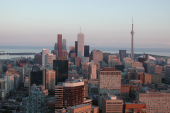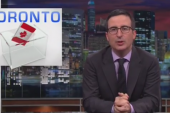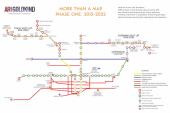
 (Michael Takasaki) Just as construction was getting underway, Toronto’s latest set of transit plans have evaporated with another mighty “yoink!” The Transit City plan, which would have sent tram-like trains down a patchwork of arterial roads, has been on the chopping block since Ford’s election. “The war on cars is over,” he declared: no longer should Toronto’s cars have to share the road with their fine bogeyed friends. Now, at last, we know what our new mayor has arranged replace Transit City with: One great, honking, $8.7 billion tunnel beneath Eglinton, all the way from Kennedy to Jane, built and paid for by the province. (Ford would also like to finish the Sheppard subway line – but he’s got no concrete plan to pay for it, and the drawing board is blank, so it’s not a prospect to bank on.) Years of work, and at least $49 million in local consultations, environmental assessments, engineering work and broken contracts have gone down the drain. That provincial $8.7 billion would have bought 52 km of LRT track, whereas now it’s buying 25 km of subway. The progressive left is screaming blue murder. But is the result all bad? Heresy alert: Maybe not. Rob Ford, a man who has no love for transit, might have gone and done the right thing for the wrong reasons. Transit City wasn’t just a transit plan; it was an article of faith for the left. The plan would have pushed a handful of light-rail lines down – for the most part – the middle arterial roads, creating something like the St. Clair right-of-way, but with fewer stops and larger trains. It was sold as “subways lite” – cheap and practical transit. Not only was it to be the most tangible legacy of the Miller administration, but it embodied some of their most cherished precepts about city-building. In fact, the city-building upsides seemed to trump the idea of transit itself. One priority was casting transit as a social service: Its various branches would have reached needy neighbourhoods like Malvern and Jane/Finch, promising opportunity for local residents through transit. Transit City also promised to remake the suburban landscape. Light rail, it was hoped, would render wide suburban roads less bleak, and attract the kind of attractive, medium-height development that Toronto planners crave (even if Toronto developers haven’t exactly matched their enthusiasm). Transit City’s public-outreach material featured endless pictures of trams running through carefully manicured, generically European streets. The idea seemed to be that if we built enough European-style trams, our streets might turn into a bit of European-style Europe. It was a nice thought. The problem is these upsides are all just collateral benefits of transit. What about transit for the sake of, well, transit – the act of moving people quickly around the city? Transit City might have been a genuine boon to its neighbourhoods. But it gave every indication of being a lousy way to get across town. For one thing, it’s slow. Advocates like the Toronto Environmental Alliance claim that, on average, Toronto’s street-level LRTs would be only slightly slower than subways. But these numbers, like Ford’s fundraising schemes for the Sheppard line, live in the gauzily optimistic land of theory. LRT design can be finessed in a number of ways, but there’s no getting around the fact that streetcars have to stop at cross-streets so cars can get through. Jiggery-pokery involving meticulous control of traffic lights can help, but it doesn’t always get implemented by reluctant traffic departments. Then there’s the process of extracting fares from customers, which subways don’t face. In San Francisco and Boston, similarly-planned LRTs grind their way, stop by stop, through the city. At MIT, students sell “I Hate the Green Line” T-shirts, after the local LRT – the busiest in America, and whose excursions are, shall we say, leisurely. (I saw these shirts myself, while quietly hating the Green Line.) Even more troublesome was the fact that Transit City was a patchwork of stubs. Instead of running across town and connecting nodes, Transit City lines dangled off of existing subway lines like little vestigial organs. (The Eglinton Crosstown line – which Ford has preserved – was the one promising exception.) This setup might have been workable for riders who just wanted to get downtown. But what if downtown isn’t the centre of your universe? What if a commuter needed, for instance, to get from a house in a suburb near Sheppard East to a job near Finch West? With Transit City – deep breath! – the trip would have gone like this: Bus to Sheppard LRT, LRT to Sheppard subway, subway to Sheppard bus, bus to University subway, subway up one stop, subway to Finch LRT. Try doing that twice a day, every day. Wouldn’t you just rather get on a bus and go west, then up? Or, you know, buy a car? Transfers, connections and commuting times pile up, and have a significant effect on quality of life. There’s a reason that Transit City’s detractors called it “Transfer City” from the outset. An effective transit network needs big pipes and small pipes, arteries as well as capillaries. It takes big pipes to get to the right end of town quickly, and small pipes to get to where you’re going. What’s more, they all need to connect. Transit City skipped the arteries and went straight to the capillaries. Why? Because, Torontonians were told, capillaries are so much cheaper, and offer great value for money. But in the long run, cheapness doesn’t pay. Yes, for the price of one subway megaproject, we could run twice as many kilometers of light rail. But if that light rail, chopped up across the map, isn’t fast or connected enough to offer Torontonians a real choice in navigating the city, then what’s the point? Rob Ford’s plan builds just one artery, at immense cost, but it builds it fully. When building a network, one complete project is better than a handful of half-projects. The new Eglinton subway will go from the heart of Scarborough all the way to the edge of Etobicoke. It will do it at full speed. It will take riders that whole way without a transfer. We haven’t built anything this significant since the late 1970’s. Ford’s new plan is heavy-handed, short on nuance, and doesn’t give a fig about city-building or whether the streetscape above looks like Milan or Sudbury. It’s an expensive, essential artery that the left, hoping to do it all, couldn’t commit to. It will simply let people move, quickly and effectively, from one densely populated part of the city to another. And maybe that’s not such a bad way to think about what transit ought to do.
(Michael Takasaki) Just as construction was getting underway, Toronto’s latest set of transit plans have evaporated with another mighty “yoink!” The Transit City plan, which would have sent tram-like trains down a patchwork of arterial roads, has been on the chopping block since Ford’s election. “The war on cars is over,” he declared: no longer should Toronto’s cars have to share the road with their fine bogeyed friends. Now, at last, we know what our new mayor has arranged replace Transit City with: One great, honking, $8.7 billion tunnel beneath Eglinton, all the way from Kennedy to Jane, built and paid for by the province. (Ford would also like to finish the Sheppard subway line – but he’s got no concrete plan to pay for it, and the drawing board is blank, so it’s not a prospect to bank on.) Years of work, and at least $49 million in local consultations, environmental assessments, engineering work and broken contracts have gone down the drain. That provincial $8.7 billion would have bought 52 km of LRT track, whereas now it’s buying 25 km of subway. The progressive left is screaming blue murder. But is the result all bad? Heresy alert: Maybe not. Rob Ford, a man who has no love for transit, might have gone and done the right thing for the wrong reasons. Transit City wasn’t just a transit plan; it was an article of faith for the left. The plan would have pushed a handful of light-rail lines down – for the most part – the middle arterial roads, creating something like the St. Clair right-of-way, but with fewer stops and larger trains. It was sold as “subways lite” – cheap and practical transit. Not only was it to be the most tangible legacy of the Miller administration, but it embodied some of their most cherished precepts about city-building. In fact, the city-building upsides seemed to trump the idea of transit itself. One priority was casting transit as a social service: Its various branches would have reached needy neighbourhoods like Malvern and Jane/Finch, promising opportunity for local residents through transit. Transit City also promised to remake the suburban landscape. Light rail, it was hoped, would render wide suburban roads less bleak, and attract the kind of attractive, medium-height development that Toronto planners crave (even if Toronto developers haven’t exactly matched their enthusiasm). Transit City’s public-outreach material featured endless pictures of trams running through carefully manicured, generically European streets. The idea seemed to be that if we built enough European-style trams, our streets might turn into a bit of European-style Europe. It was a nice thought. The problem is these upsides are all just collateral benefits of transit. What about transit for the sake of, well, transit – the act of moving people quickly around the city? Transit City might have been a genuine boon to its neighbourhoods. But it gave every indication of being a lousy way to get across town. For one thing, it’s slow. Advocates like the Toronto Environmental Alliance claim that, on average, Toronto’s street-level LRTs would be only slightly slower than subways. But these numbers, like Ford’s fundraising schemes for the Sheppard line, live in the gauzily optimistic land of theory. LRT design can be finessed in a number of ways, but there’s no getting around the fact that streetcars have to stop at cross-streets so cars can get through. Jiggery-pokery involving meticulous control of traffic lights can help, but it doesn’t always get implemented by reluctant traffic departments. Then there’s the process of extracting fares from customers, which subways don’t face. In San Francisco and Boston, similarly-planned LRTs grind their way, stop by stop, through the city. At MIT, students sell “I Hate the Green Line” T-shirts, after the local LRT – the busiest in America, and whose excursions are, shall we say, leisurely. (I saw these shirts myself, while quietly hating the Green Line.) Even more troublesome was the fact that Transit City was a patchwork of stubs. Instead of running across town and connecting nodes, Transit City lines dangled off of existing subway lines like little vestigial organs. (The Eglinton Crosstown line – which Ford has preserved – was the one promising exception.) This setup might have been workable for riders who just wanted to get downtown. But what if downtown isn’t the centre of your universe? What if a commuter needed, for instance, to get from a house in a suburb near Sheppard East to a job near Finch West? With Transit City – deep breath! – the trip would have gone like this: Bus to Sheppard LRT, LRT to Sheppard subway, subway to Sheppard bus, bus to University subway, subway up one stop, subway to Finch LRT. Try doing that twice a day, every day. Wouldn’t you just rather get on a bus and go west, then up? Or, you know, buy a car? Transfers, connections and commuting times pile up, and have a significant effect on quality of life. There’s a reason that Transit City’s detractors called it “Transfer City” from the outset. An effective transit network needs big pipes and small pipes, arteries as well as capillaries. It takes big pipes to get to the right end of town quickly, and small pipes to get to where you’re going. What’s more, they all need to connect. Transit City skipped the arteries and went straight to the capillaries. Why? Because, Torontonians were told, capillaries are so much cheaper, and offer great value for money. But in the long run, cheapness doesn’t pay. Yes, for the price of one subway megaproject, we could run twice as many kilometers of light rail. But if that light rail, chopped up across the map, isn’t fast or connected enough to offer Torontonians a real choice in navigating the city, then what’s the point? Rob Ford’s plan builds just one artery, at immense cost, but it builds it fully. When building a network, one complete project is better than a handful of half-projects. The new Eglinton subway will go from the heart of Scarborough all the way to the edge of Etobicoke. It will do it at full speed. It will take riders that whole way without a transfer. We haven’t built anything this significant since the late 1970’s. Ford’s new plan is heavy-handed, short on nuance, and doesn’t give a fig about city-building or whether the streetscape above looks like Milan or Sudbury. It’s an expensive, essential artery that the left, hoping to do it all, couldn’t commit to. It will simply let people move, quickly and effectively, from one densely populated part of the city to another. And maybe that’s not such a bad way to think about what transit ought to do.














